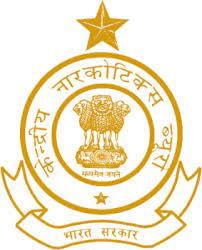UPSC Daily Current Affairs- 14th April 2023 | Current Affairs & Hindu Analysis: Daily, Weekly & Monthly PDF Download
GS-I
Teja Singh Suntantar
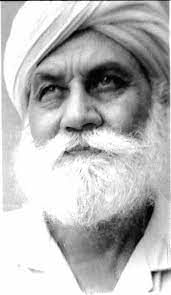
Why in News?
Punjab CM unveiled a statue of Teja Singh Sutantar, former MP and revolutionary leader at Nihalgarh village in Sangrur district.
- Nearly 784 villages had taken part in the PEPSU Muzara movement, led by Teja Singh. Nihalgarh was one of these villages.
About Teja singh Sutantar
- Early life:
- Born as Sumand Singh in Aluana village of Gurdaspur. (16 July 1901 − 12 April 1973).
- He became Teja Singh when he liberated Veela Teja gurdwara from the clutches of the British-backed Mahants..
- Sutantar was added to his name when he led ‘Sutantar jatha’, which was at the forefront of gurdwara liberation.
- Contributions:
- In early 1923 , Teja Singh went to Kabul as a Sikh missionary. There he came in contact with a few leaders of the Ghadar Party.
- The Ghadar Movement was an early 20th century international political movement founded by expatriate Indians to overthrow British rule in India.
- In 1925, he joined the Turkish military academy under the pseudonym Azad Beg.
- He would eventually be granted Turkish citizenship and be commissioned into the Turkish army.
- He saved the life of Dr Saifuddin Kitchlew, the hero of Jallianwala Bagh, Kitchlew always referred to Sutantar as a ‘khuda’ who saved his life,”.
- He contributed revolutionary articles to the party journal, the Kirti, frequently writing about issues that plagued peasants.
- He edited Lal Jhanda, a monthly magazine in Urdu, Lal Savera, a Punjabi weekly and contributed to various newspapers.
- Saved hundreds of Muslims from communal riots during the Partition.
- He joined the Akali Dal to participate in the movement of liberating gurdwaras from degenerate mahants.formed his own squad called ‘sutantar jatha’ .
- Post-independence, Teja Singh, who was a prominent leader of the Kisan Sabha, led a number of peasant agitations against the government and landlords.
- He formed his Lal (Red) Party with the Kirti group of the Punjab Communist Party as its nucleus
- He was a revolutionary leader who led the PEPSU Muzara movement,
- In early 1923 , Teja Singh went to Kabul as a Sikh missionary. There he came in contact with a few leaders of the Ghadar Party.
PEPSU MUZARA MOVEMENT
- Back ground:
- In the 1870, the Maharaja of Patiala implemented the Biswedari system also known as landlord system.
- Under this system, the Biswedaris were appointed as the local authorities of villages.
- They were mostly government officials and were closely related to Maharaja and gradually took possession of the lands.
- The original owners of the land were reduced to mere status of muzaras or tenants.
- The muzaras were forced to pay batai and surrender half of the crops to their landlords.
- Movement:
- The PEPSU Muzara movement started in the 1930s and went on till 1952 against the Biswedari system.
- By landless peasants (muzaras) in PEPSU (Patiala and East Punjab States Union to obtain ownership rights of the land they had been tilling for generations.
- For their hereditary property right and democratic right from the British, The native aristocracy .
- The farmers would finally receive land rights in 1952.
Source: Indian Express
Gond Painting
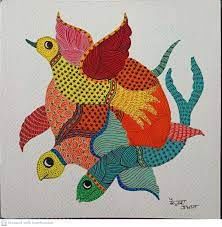
Why in News?
Recently, the famous Gond painting of Madhya Pradesh has received the prestigious Geographical Indication (GI) tag.
About Gond Painting:
- It is a famous folk art of the Gond tribal community of central India.
- It is done to preserve and communicate the culture of the Gond tribal community.
- Themes: Gond tribes are highly interlinked with nature and this appears in their paintings too they include animals, mahua tree, mythological stories, Hindu gods, Local deities and folktales etc.
- Each Gond artist uses his distinctive pattern and style to fill the images these style signatures are used in collage to make a complete picture such as Dots, fine Lines, Curved Lines, Dashes Fish Scales etc.
Key facts about Gond Tribe
- The Gonds are the largest tribal Community in India and can be traced to the pre-Aryan era.
- The word Gond comes from Kond, which means green mountains.
- They are a heterogeneous group spreading over large areas from the Godavari gorges in the south to the Vindhya Mountains in the north.
- They live in the states of Madhya Pradesh, Maharashtra, Telangana, Andhra Pradesh, Bihar, and Odisha.
- The majority speak various mutually unintelligible dialects of Gondi.
Source: The Print
GS-II
Safeguards and procedures: On India’s preventive detention laws
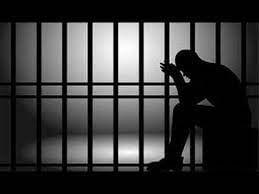
Why in News?
The Supreme Court observed in a judgment that preventive detention laws in India are a colonial legacy and confer arbitrary power to the state.
- The Court warned that these laws are extremely powerful and have the potential to provide the state with free discretion.
About Preventive Detention:
- Preventive detention means detention of a person without trial and conviction by a court.
- Its purpose is not to punish a person for a past offence but to prevent him from committing an offence in the near future.
- The detention of a person cannot exceed three months unless an advisory board reports sufficient cause for extended detention.
- Protection:
- Article 22 grants protection to persons who are arrested or detained.
- Article 22 has two parts—the first part deals with the cases of ordinary law and the second part deals with the cases of preventive detention law.
Two Types of Detentions:
- Preventive detention is when a person is held in police custody only on the basis of a suspicion that they would conduct a criminal act or cause harm to society.
- The police have the authority to hold anyone they suspect of committing a criminal offence and also to make arrests without a warrant or a magistrate’s authorization in certain cases.
- Punitive detention, which means detention as a punishment for a criminal offence. It occurs after an offence is actually committed, or an attempt has been made towards the commission of that crime.
Preventive Detention Laws in India: Parliament passed a legislation named Preventive Detention Act, 1950 which talks about the detention of a person on the grounds of defense, foreign affairs or the security of the state.
History:
- The constitutionality of Preventive Detention Act, 1950 was challenged in the case of K. Gopalan V. State of Madras where a leader named A.K. Gopalan was detained in Madras jail from 1947.
- He challenged the validity of the aforesaid act as this act of state of further detaining him is in violation of Article 13, Article 19 and Article 21 and provisions of the act are not in accordance with Article 22 enshrined under the Constitution of India.
- The case was decided by 4:1 ratio, where the majority does not recognize detention as an infringement of personal liberty under Article 21.
- Minority view in the case: Preventive detention, which is dealt with in Article 22, also amounts to deprivation of personal liberty which is referred to in Article 21, and is a violation of the right of freedom of movement dealt with in Article 19(1)(d).
- The interrelationship between fundamental rights paved the way for acknowledging privacy as a fundamental right in Justice K.S. Puttaswamy case by overruling MP Sharma and Kharak Singh case.
Safeguard Against Misuse of Preventive Detention
- Time-period: A person may be taken to preventive custody only for 3 months at the first instance.
- If the period of detention is extended beyond 3 months, the case must be referred to an Advisory Board consisting of persons with qualifications for appointment as judges of High Courts.
- Permission of Advisory board: It is implicit that the period of detention may be extended beyond 3 months, only on approval by the Advisory Board.
- Grounds of detention: Detainee is entitled to know the grounds of his detention.
- The state, however, may refuse to divulge the grounds of detention if it is in the public interest to do so.
- This power conferred on the state leaves scope for arbitrary action on the part of the authorities.
- Legal options: Detaining authorities must give the detainee earliest opportunities for making representation against the detention.
Concerns:
- The government holds the right to conceal information which it considers to be against public interest to disclose.
- The power of preventive detention is mostly misused by the authorities.
- The use of preventive detention even during peacetime denotes ‘anachronism’.
- It is a matter of irony that the makers of our Constitution, who themselves were once victims of the tyranny of preventive detention laws, still chose to grant powers to governments under the Constitution to enact such laws.
- According to Section 50 of the Criminal Procedure Code (CRPC), any person arrested has to be informed of the grounds of arrest and has the right to bail.
- But getting bail is not a simple task in reality.
Way Forward:
The preventive detention should be strictly used with the delicate balance between social security and citizen freedom. As the Supreme Court has observed that to prevent misuse of this potentially dangerous power, the law of preventive detention has to be strictly construed and need to follow meticulous compliance with the procedural safeguards. There is an urgent need to ensure this.
Source: The Hindu
Central Bureau of Narcotics
Why in News?
The Revenue secretary launched the unified portal of the Central Bureau of Narcotics.
Features of the portal
- Cloud-based storage, simplified process, and database integration with other government services, including Bharat Kosh, GST, PAN- NSDL validation, e-Sanchit, and UIDAI.
Significance
- It will instill efficiency, transparency and accountability to reduce the time taken by the pharma industry to get a trade license.
- To cater the need and synergistic growth of the drugs & pharma sector.
- Ensure availability of the “essential narcotic drugs" and medicines to the patients & their attendants.
Central Bureau of Narcotics
- About:
- Central Bureau of Narcotics is a subordinate office under the Department of Revenue, Ministry of Finance.
- HQ: Gwalior
- It works under the ambit of various United Nations Conventions and the provisions of NDPS Act, 1985.
- India is a signatory to the UN Convention on Narcotic Drugs 1961, UN Convention on Psychotropic Substances 1971 and UN Convention against the Illicit Traffic in Narcotic Drugs and Psychotropic Substances, 1988 which obligates member countries to monitor the implementation of the United Nations drug control conventions.
- Functions:
- Supervision over licit cultivation of opium poppy in India .
- Preventive and enforcement functions.
- Investigation of cases under the NDPS Act 1985
- Issuance of Export Authorizations/ Import Certificate for export.
- Issuance of No Objection Certificate (NOC) for import/export of Precursor Chemicals.
- Composition:
- Headed by the Narcotics Commissioner (NC) & assisted by three Deputy Narcotics Commissioners (DNCs).
- Other officers
Source: Live Mint
GS-III
Bioluminescence
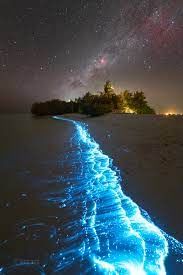
Why in News?
Recently, a group of MTech students noticed something unusual along the coast of Visakhapatnam which was glowing due to a unique natural phenomenon called bioluminescence.
About Bioluminescence:
- What is it? Bioluminescence occurs due to the presence of some marine planktons called dinoflagellates that produce light when the water is disturbed.
- These planktons emit light on the ocean surface at night.
- Bioluminescent is widespread among deep sea animals in general.
- Many marine creatures like sponges, jellyfish, worms, species of fish, anthropods, echinoderms and unicellular alga exhibit bioluminescence to either evade predators, attract prey or during mating.
- In Visakhapanam, this phenomenon is most likely the result of an algal bloom of the dinoflagellate species of noctiluca and ceratium.
- This occurs when the luciferase enzyme reacts with luciferin compound in the presence of oxygen to produce a cold light.
- This is widespread in lagoons and sometimes breakwaters and is particularly visible during warm weather conditions.
- The dinoflagellates follow a circadian cycle (24-hour cycle) and as a result this phenomenon occurs during the night which is visible in low light conditions.
- This unique phenomenon has been visible in some other beaches in India including Havelock Island in the Andamans, Thiruvanmiyur beach in Chennai, Mattu beach in Karnataka and Bangaram Island in Lakshadweep.
What are Planktons?
- Plankton are a group of marine and freshwater organisms that drift along ocean currents because they are too small or weak to swim against them.
- Their name comes from the Greek word planktos which means “wandering.”
- The range in size from 2 micrometers to more than 20 centimeters.
- There are two types of plankton: phytoplankton, which are tiny plants, and zooplankton, which are tiny animals.
Source: The Hindu
Large Hadron Collider (LHC)
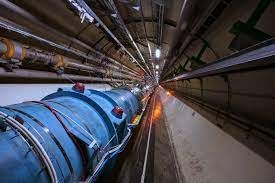
Why in News?
Currently, engineers are warming up the Large Hadron Collider (LHC) for its third season of operations.
Large Hadron Collider (LHC)
- The LHC is the world’s largest science experiment that smashes tiny particles called hadrons together at really high speeds. It uses protons as the particles and has a long circular pipe where they’re accelerated.
- It is built by the European Organisation for Nuclear Research (CERN).
- LHC’s goal is to test the Standard Model, the mathematical framework physicists use to describe all of the known fundamental particles in the universe and the forces through which they interact.
- LHC studies the smallest known building blocks of matter. It fires two beams of protons almost at the speed of light in opposite directions, guided by the magnetic field of superconducting electromagnets.
- ATLAS is the largest general purpose particle detector experiment at the LHC; the Compact Muon Solenoid (CMS) experiment is one of the largest international scientific collaborations in history, with the same goals as ATLAS, but which uses a different magnet-system design.
- Ten years ago, on July 4, 2012, scientists at CERN had announced to the world the discovery of the Higgs boson or the ‘God Particle’ during the LHC’s first run.
- Higgs boson is the fundamental force-carrying particle of the Higgs field, which is responsible for granting other particles their mass.
- Peter Higgs and his collaborator François Englert were awarded the Nobel Prize for physics in 2013 for the discovery of the Higgs Boson.
- Observed exotic particles like pentaquarks and tetraquarks and checked if their properties are in line with theoretical expectations
- Quarks are elementary particles that usually combine in groups of twos and threes to form hadrons such as the protons and neutrons that make up atomic nuclei.
- European Organisation for Nuclear Research (CERN) is the world’s largest nuclear and particle physics laboratory.
- CERN is based in Geneva on the French-Swiss border. It has 23 member states.
- India in 2016 became an associate member of the CERN. Indian scientists have played a significant role in the ALICE experiment, which is a dedicated experiment for search and study of Quark Gluon Plasma (QGP).
Cost inflation index (CII)

Why in News?
Recently, the Central Board of Direct Taxes (CBDT) has notified the provisional cost inflation index (CII) for the fiscal 2023-24.
About Cost inflation index (CII):-
- The CII is an index that is used to calculate the inflation-adjusted rise in the value of an asset including land, buildings, houses, gold jewellery, debt mutual funds, and so on.
- This CII number will assist in determining the long-term capital gains on which one is required to pay taxes while filing your income tax returns (ITR) next year.
- This number is used to calculate inflation-adjusted cost for only those assets that allow for inflation-adjusted (indexation benefit).
- As a result, the CII value cannot be used to calculate LTCG/LTCL on equity mutual funds.
- This is because any sum above Rs 1 lakh each fiscal year is taxed at a flat rate of 10% without the advantage of indexation.
Calculating CII:-
- The formula to calculate inflation-adjusted cost price is:
- (CII of the year of sale/CII for the year of purchase) * Actual cost price.
- The government declared in Budget 2017 that the base year would be changed from 1981 to 2001 due to challenges in obtaining appropriate information by taxpayers.
SOURCE: FINANCIAL EXPRESS
|
38 videos|5293 docs|1118 tests
|
FAQs on UPSC Daily Current Affairs- 14th April 2023 - Current Affairs & Hindu Analysis: Daily, Weekly & Monthly
| 1. What are the three components of the UPSC exam? |  |
| 2. What is the significance of General Studies Paper I in the UPSC exam? |  |
| 3. What is the role of General Studies Paper II in the UPSC exam? |  |
| 4. What topics are covered in General Studies Paper III of the UPSC exam? |  |
| 5. How can I prepare for the UPSC exam's General Studies papers? |  |

